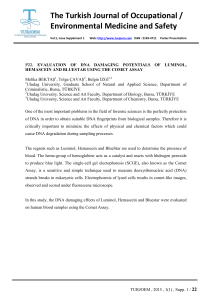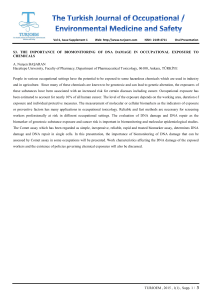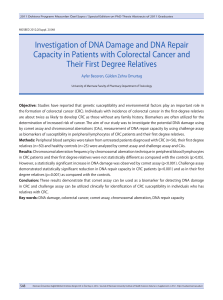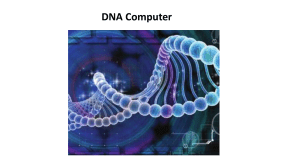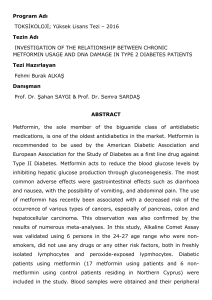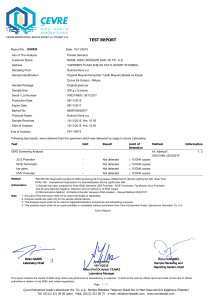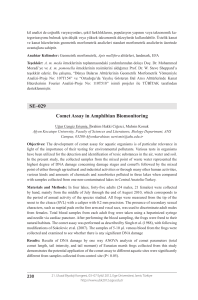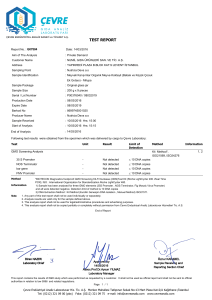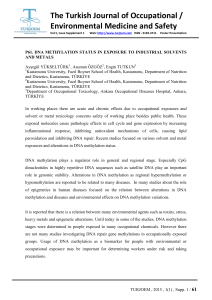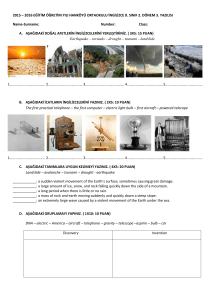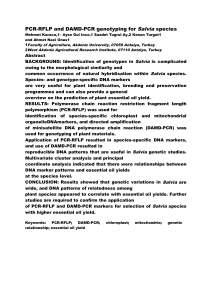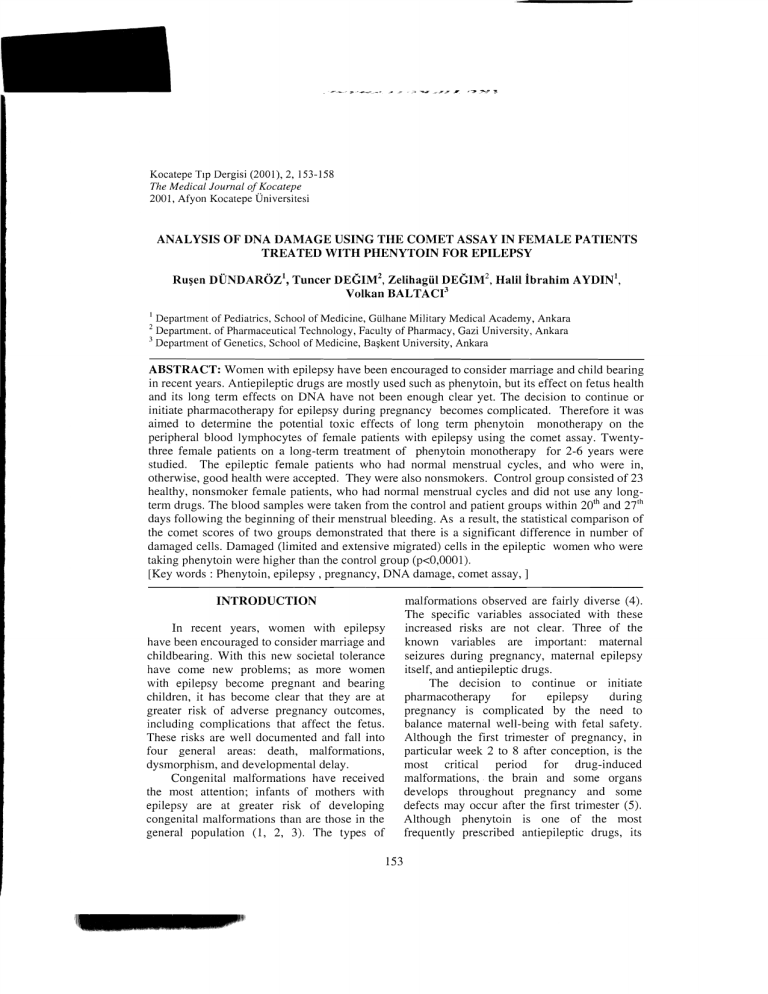
Kocatepe TIp Dergisi (2001), 2, 153-158
The Medical Journal of Kocatepe
2001, Afyon Kocatepe Universitesi
ANALYSIS OF DNA DAMAGE USING THE COMET ASSAY IN FEMALE PATIENTS
TREATED WITH PHENYTOIN FOR EPILEPSY
Rusen DUNDAROZ l , Tuncer DEGIM 2, Zelihagiil DEGIM 2 , HaHI Ibrahim AYDIN l ,
Volkan BALTACI3
Department of Pediatrics, School of Medicine, Gulhane Military Medical Academy, Ankara
Department. of Pharmaceutical Technology, Faculty of Pharmacy, Gazi University, Ankara
3 Department of Genetics, School of Medicine, Baskent University, Ankara
1
2
ABSTRACT: Women with epilepsy have been encouraged to consider marriage and child bearing
in recent years. Antiepileptic drugs are mostly used such as phenytoin, but its effect on fetus health
and its long term effects on DNA have not been enough clear yet. The decision to continue or
initiate pharmacotherapy for epilepsy during pregnancy becomes complicated. Therefore it was
aimed to determine the potential toxic effects of long term phenytoin monotherapy on the
peripheral blood lymphocytes of female patients with epilepsy using the comet assay. Twenty­
three female patients on a long-term treatment of phenytoin monotherapy for 2-6 years were
studied. The epileptic female patients who had normal menstrual cycles, and who were in,
otherwise, good health were accepted. They were also nonsmokers. Control group consisted of 23
healthy, nonsmoker female patients, who had normal menstrual cycles and did not use any long­
term drugs. The blood samples were taken from the control and patient groups within 20 th and 27th
days following the beginning of their menstrual bleeding. As a result, the statistical comparison of
the comet scores of two groups demonstrated that there is a significant difference in number of
damaged cells. Damaged (limited and extensive migrated) cells in the epileptic women who were
taking phenytoin were higher than the control group (p<O,OOO 1).
[Key words: Phenytoin, epilepsy, pregnancy, DNA damage, comet assay, ]
INTRODUCTION
malformations observed are fairly diverse (4).
The specific variables associated with these
increased risks are not clear. Three of the
known variables are important: maternal
seizures during pregnancy, maternal epilepsy
itself, and antiepileptic drugs.
The decision to continue or initiate
pharmacotherapy
for
epilepsy
during
pregnancy is complicated by the need to
balance maternal well-being with fetal safety.
Although the first trimester of pregnancy, in
particular week 2 to 8 after conception, is the
most
critical
period for
drug-induced
malformations, . the brain and some organs
develops throughout pregnancy and some
defects may occur after the first trimester (5).
Although phenytoin is one of the most
frequently prescribed antiepileptic drugs, its
In recent years, women with epilepsy
have been encouraged to consider marriage and
childbearing. With this new societal tolerance
have come new problems; as more women
with epilepsy become pregnant and bearing
children, it has become clear that they are at
greater risk of adverse pregnancy outcomes,
including complications that affect the fetus.
These risks are well documented and fall into
four general areas: death, malformations,
dysmorphism, and developmental delay.
Congenital malformations have received
the most attention; infants of mothers with
epilepsy are at greater risk of developing
congenital malformations than are those in the
general population (1, 2, 3). The types of
153
toxicity on DNA has not been enough clear
yet.
The purpose of this study was to
determine the potential toxic effects of long
term phenytoin monotherapy in the peripheral
blood lymphocytes of female patients with
epilepsy using the comet assay.
MATERIALS AND METHODS
Twenty-three female patients on a long­
term treatment of phenytoin monotherapy for
2-6
years
(mean=3,547±J.l71
years;
±SD,n=23) were studied. The epileptic female
patients who had normal menstrual cycles, and
who were in, otherwise, good health were
accepted.
They were also nonsmokers.
Control group consisted of 23 healthy,
nonsmoker female patients, who had normal
menstrual cycles and did not use any long-term
drugs. Both, the patient group and control
group were informed about the study . The
informed consent of the patients and the
necessary permissions from the ethical
committee were obtained. The blood samples
were taken from the control and patient groups
within 20 th and nIh days following the
beginning of their menstrual bleeding. To our
knowledge, neither the patients receiving
phenytoin nor the control group were exposed
to any other mutagenic agents (e.g ., radiation,
chemicals, lifestyle, smoking, drugs, or
viruses) during the at least one year before the
study . All subjects were healthy at the time of
sampling. Five ml of blood was carefully
layered over eight ml Lymphocyte Separation
Medium and centrifuged at 2000 x g for 15
min. After the plasma layer was removed and
saved, the buff coat was carefully removed and
the cells were washed with TC-199 medium.
Then they were collected by a 10 min
centrifugation at 1000 x g. Lymphocytes were
re-suspended at approximately 10 7/ ml in TC­
199 medium with 20% v/v plasma and 10% v/v
plasma and v/v DMSO. Lymphocytes were
transferred to microfuge tubes, and they were
stored at -20 °C. The comet assay was
performed as described previously (6). Comets
from as broken ends of the negatively charged
154
.,
DNA molecule become free to migrate in the
electric field towards the anode. The assay
provides direct determination of the extent of
DNA. Damage in individual cells and the
extent of DNA damage can be assessed from
the length of DNA migration. And , this is
derived by subtracting the diameter of the
nucleus from the total length of the image . The
degree of damage was determined by grading
the cells as: Normal (undamaged - no
migration), Limited migration (at low damage
levels, stretching of attached strands of DNA,
rather than migration of individual pieces is
likely to occur), and Extensive migration (with
increasing numbers of breaks, DNA pieces
migrate freely into the tail forming comet
images) . Minimum of 100 cells were analyzed
for each study subject. Slides were scored
blindly by the independent investigator.
Statistical comparisons between the grade of
DNA damages in control/patient groups were
analyzed by using Student t test which assumes
Gaussian populations with equal SD's and two
sided P values were used.
RESULTS
The ages of the patient group ranged from
24 to 39 years (30,652±4,829; ±SD,n=23). The
ages of the controls ranged from 23 to 39 years
(29,826±5,882; ±SD,n=23). The statistical
comparison of the ages in two groups showed
no significant difference (p>0,05). The comet
scores and clinical data of the patient and
control groups are summarized in Table-I. The
statistical comparison of the comet scores of
two groups demonstrated that there is a
significant difference in number of damaged
cells . Damaged (limited and extensive
migrated) cells in the epileptic women who
were taking phenytoin were higher than those
of the controls (p<O,OOO 1).
DISCUSSION
Phenytoin has been used extensively due
to the low cost, once-daily dosing, efficacy,
and IV formulation. It is associated with fetal
hydantoin syndrome characterized by a wide
spectrum of malformations including digit and
nail
hypoplasia,
polid actyly,
gro wth
retard ation , typ ical facial appearance, rib
anomalies, abnor ma l palm ar creases, hir sut ism ,
and low hairlines and anomalies of the heart
and central nervous sys tem and rare ly
arnbigious ge nitalia in infa nts born to women
taking phenyt oin du ring pregnancy (7) .
Antiepileptic dru gs, particul arly phen ytoin ,
have been suspec ted to be toxic on DN A in
hum ans and ex perime ntal anima ls. It forms a
highl y reacti ve are nox ide interm edi ate known
to have cy totoxic, teratogeni c and carcinogenic
properties, du ring its biotransformat ion . It is
reported that the ge notoxic effects of phenyt oin
mediated by this inter media twe metabolite (8) .
In some inves tiga tio ns, It has been rep orted
increas ed SC E frequencies ex pose d to higher
phe nytoin co nce ntrations (9 , 10), increased the
frequencies of chro moso mal aberations ( 11),
frames hift
mutation s
in
sa lmo nella
typh imurium (12), and SCE induction by in
vitro phen ytoin treatm ent (13). In an other
study also , it has been found that phenytoin
whe n added to cultures of normal hum an
lymph ocytes increased the frequency of SC E,
and this inc rease was dose depend ent (14 ).
On the oth er hand, it has been report ed
that phenytoin, phenobarbit al, ca rbamaze pine
and primido ne and their metabolites show ed no
effect on SCE frequ ency (15). In an other
study also, no mut agenic effect of phenytoin
co uld be dem onstr ated as revealed by SC E (
there was no difference in the frequency of
SCE betw een treated and unt reated gro ups),
but , all the subje cts in this study (epileptic and
non-epilept ic) were cases of cerebral palsies
due to perinata l asphyx ia ( 16).
Th e single ce ll gel elec trophores is
(SCGE) assay also kn own as co met assay is a
155
rapid simple, visual and sensitive techniqu e for
measurement and analyzing DNA breakage in
mamm alian ce lls. One of the adva ntages of
SCGE assay is that it ca n be used to meas ure
DNA breaks in virtu all y any ce ll type. DNA
dam age is know n as respo nsible fro m
teratogen ity and ca ncerogenesis (17-22) .
Several studies eva luated the effects of
pheny toin on DNA, but none of them has used
the co met assay until now. For the first time,
we used the co met ass ay to investigate the
toxic effects of phen ytoin on DNA in the
peripheral lymph ocytes of fema le epileptic
patients treated with on ly phen ytoin. We
found a significa nt difference in the co met
sco res between the patien ts and the health y
women. The factors that may have influ ence
on the co met scores (age, sex, race, nutrition ,
environ etc.) were simi lar in both gro ups.
Physiological factors that may have effe cts on
DNA are rep rodu cti ve hormones; eva luation of
SCE frequencies duri ng a normal menstru al
cycle de mo nstrated a higher rate of ovulation,
and in the luteal phase as co mpared to the early
follicular phase (23). In our study, all the
subjects (patients and the co ntro l gro up) were
at the same phase of the men stru al cycle
(within zo" and 27 th days followi ng the
begin ning of menstru al bleeding) at the time of
sampling.
Therefore, we think that the
difference in the co met scores was ind uced by
the expos ure to the phen ytoin. T hese results
support the idea that the expos ure to phen ytoin
is associated with DNA dam age whi ch may be
associated with teratogen ity. We sugges t that
this possi ble toxic effect of phen yto in sho uld
be co nsidere d in the treatm ent of ep ilepsy,
es pecia lly in women who may be pregna nt.
.,q""
H. I II , t ' i~!" llll llnl ' I ! Ifl'j . ;1I11 IW
t
Table 1. Clinical data and co met scores obtained from the patients and co ntrol subj ects.
CONTROL GROUP
EPILEPTIC WOMEN TREATED WITH PHENITOIN
Subject
Age
(years)
I
2
3
4
5
6
7
8
9
10
II
12
13
14
15
16
17
18
19
20
21
22
23
Mean
SD
n
27
24
34
31
36
37
25
28
29
32
34
35
26
39
27
26
25
29
34
36
38
24
29
30,652
4.829
23
Usage
periode
(years)
2.5
2.8
3.5
4
3.7
5.9
6
5
3
2.5
2.7
3.5
3.1
2.5
3.5
3.7
6
4
2
2.8
2.6
3.8
2.5
3.547
1.1 71
23
Undamaged Limited
(no miggration) migration
7
12
9
8
8
13
7
9
9
8
7
6
90
79
87
86
89
79
90
87
85
84
90
91
83
88
85
86
85
87
91
88
85
83
87
II
9
II
8
8
8
7
9
9
II
9
86.304
3.308
23
Extensive
migration
3
9
4
6
3
8
3
4
6
8
3
3
6
3
4
6
7
5
2
3
6
6
4
8.826
1.749
23
4.869
1.961
23
R E FERE NCES
I.
2.
3.
4 .
Meadow SR : An ticonvu lsant drugs and
conge nital anomalies. Lancet. 2: 1296­
1300, 1968
Nakane Y, Ok uma T, Takahashi R :
Mu lti-instituti onal
study
on
the
teratogen icity and fetal toxicity of
antico nvulsa nts:
a
report
of
a
co llaborative study group in Japan.
Epilepsia, 21: 663-680. 1980
Philbert A. Dam M: The epile ptic mother
and her child. Epilepsia , 23: 85-99, 1982
5.
6.
156
Age
(years)
35
39
24
29
25
27
26
28
29
24
23
38
37
39
29
25
24
25
26
24
39
37
34
29.826
5.882
23
Undamaged Limited
(nomigration) migration
96
95
100
95
98
95
93
99
94
97
99
91
92
89
94
100
97
90
93
97
92
96
92
94.956
3.1 54
23
Extensive
migration
2
3
2
2
-
-
4
2
4
6
I
I
I
I
-
5
2
I
I
I
-
6
6
8
5
3
2
3
-
-
3
7
5
2
6
3
6
3.782
2.295
23
I
3
2
I
2
I
2
1.260
1.009
23
Yerby MS . Devinsky 0 : Epil epsy and
pregnancy. In : Devinsky 0 , Feldm ann E,
Hainlin e
B,
eds .
Neurol ogical
complications of pregnancy. New York:
Raven press, 45-63, 1994
Koren G, ed, Ma ternal-fetal toxicology : a
clin ician ' s guide . 2 nd ed. New York:
Marcel Dekker, 1994.
Baltaci Y, Ayglin N, Akyo l D, et al.:
Ch romosomal aberations and alkalin e
co met assay in families with habitual
abortion. Mut at Res, 417: 47-55, 1998
,II
7.
Hanson FW, Smith OW : The fetal
hydantoin syndro me. J Pediatr, 87: 285­
290, 1975
8. Yerby MS. Pregnancy,tera togenesis, and
epilepsy. Ped iatric Neuroge netic, 12(4):
749-771 ,1 994
9. Hunke MH , Carpenter NJ: Effects of
dihenylhydan toin on the frequency of
sister chro matid exchanges in human
lymph ocytes. Cytogenetics; 3: 83-85,
1984
10. Sardas S, Ada M, Karakaya AE, Aydm N:
Sister-ch romatid exc hanges in epileptic
patients on antico nvulsant therapy . Mutat
Res, 3 13. 2 1-24, 1994
11. Maurya AK, Goy le S, Rout U and Roy 0
: Mutagenic potenti al of antico nvulsant
diphenylh ydantoin
on
hum an
lymph ocytes in vitro. Methods Find Exp.
Clin Pharmacol, 7: 109-11 2,1 985
12. Sezzano P, Raimondi M, Arboix and
Pantorotto C
Mutagenicity of
diph enylh ydantoin and some of its
metabolites
toward
Salmonella
typh imurium strains. Mutation Res, 103:
2 19-238, 1982
13. Goyle S, Maur ya AK, Kailash S,
Maheshw ari MC : Mutegenic risk in
epileptic patient s before and after
anticonvulsant therapy. Epilepsia, 8: 8 1­
86, 1987
14. Guron CS, Grewal MS , Ahuja GK :
Comp arative safety of carbamaze pine and
phenytoin in the treatment of epilepsy.
Indian J Med Res, 82: 468-470, 1985
15. Riedel L, Obe G: Mutagenicity of anti­
epi leptic drugs. II. Phenytoin, primidone
and phenobarbital. Mutat Res, 138: 71-74,
1984
16. Yamamoto K, Kohnosu T, Nakagawara
K, Sakai K : Effec ts of antiepileptic drugs
and organic brain damage on SCE
freque ncy in cerebral palsies. Tohoku J
Med , 162: 169-175 ,1 990
17. Sin gh NP, McCoy MT, Tice RR, et al: A
sim ple tech niqu e for quantit ation of low
levels of DNA dam age in individu al cells.
Exp Ce ll Res, 175 (1): 184- 191, 1988
157
18. McKelvey-Martin VJ, Green MHL,
Schmezer P, et al: The single cell
electrophoresis assay (co met assa y): A
Europea n review. Mutat Res, 288 : 47-63,
1993
19. Fairbairn OW, Olive PL, O' Neill KL.:
The comet assay: a comprehensive
review. Mutat Res, 339 (1) : 37-59, 1995
20. Tafazoli M, Kirsch-Voiders M.: In vitro
mutagenicity and ge notoxicity stud y of
1,2
-dichloroethylene,
1,1,2­
trichloroethane,
I J -dichloropropane,
1,2,3-trichloropropane
and
1,1,3­
trichloropropene, using the micronucleus
test and the alkaline single cell gel
electrophoresis techn ique (comet assay) in
human lymphocytes. Mutat Res, 371:
185-202, 1996
2 1. Frenzilli G, Betti C, Davin i T, et al:
Evaluation of DNA damage in leukocytes
of ex-smokers by Single · Cell Gell
Electrophoresis. Mutat Res, 375: 117-123,
1997
22. Hartmann A, Speit G.: The con tribution of
cytotoxicity to DNA- effects in the single
cell gel test (comet assay) . Toxicology
Letters, 90: 183-188, 1997
23. D'Souza 0 , Th omas 1M, Das BC .:
Varia tion in spontaneous chromosomal
damage as a functio n of biologic rhythm s
in women. Hum Genet , 79(1):83- 5, 1988
AUTHOURS:
R. DUNDAROZ : MD, Ass istant Professor,
Department of Pediatrics, GUlhane Mi litary
Medical Academy, Schoo l of Medicine,
An kara
T. DEGIM : PhD, Assistant Professor,
Department of Pharmaceutic al Techn ology,
Faculty of Pharmacy, Gazi Univers ity, Etiler,
Ankara
Z. DEGIM : PhD, Assistant Professor,
Department of Pharmaceutical Techn ology,
Faculty of Pharmacy, Gaz i University, Anka ra
T. GUNGOR: MD, Department of Gynecology
and Obstetrics, Dr. Zekai Tahir Bu rak
Women' s Hospital, Ankara
H. i. AYDIN: MD, Ass istant Professor,
Department of Pediatrics, Gulh ane Military
...,....,'" lllIl...III ~IIlUIllllIIIIIIII I ..
Medical
Ankara
Acade my,
School
of
Medicine,
ADRESS FOR CORRESPONDENCE:
Dr. Rusen DUND AROZ , Bag-Kur blk. 4. Blk.
No: 691l4, 06010 Etlik I Ankara
Phone: 0 3 12 325 5 173 - 0 532 5922634
E-mail :rusenmd @excite.com
V. BALT ACI: MD , Associate Professor,
Department of Gene tics, Baskent University
School of Medicine, Ankara
158
.- .-
- . - - --
-
. -
--
-
- -
.-
-- ­

